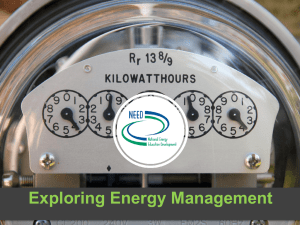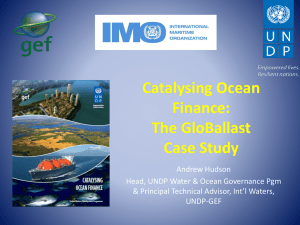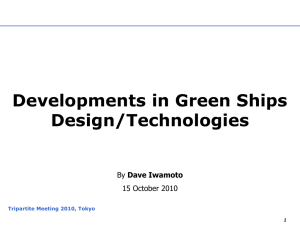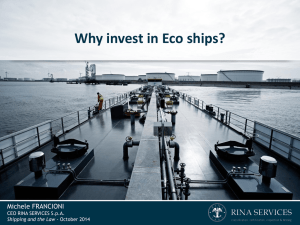Final Year Project Presentation
advertisement
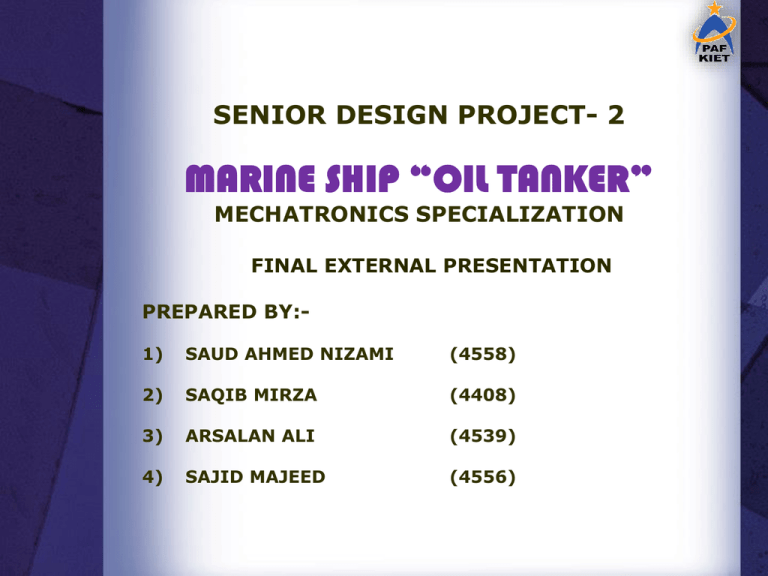
SENIOR DESIGN PROJECT- 2 MARINE SHIP “OIL TANKER” MECHATRONICS SPECIALIZATION FINAL EXTERNAL PRESENTATION PREPARED BY:1) SAUD AHMED NIZAMI (4558) 2) SAQIB MIRZA (4408) 3) ARSALAN ALI (4539) 4) SAJID MAJEED (4556) I N T R O D U C T I O N INTRODUCTION: The Marine Ship ‘Tanker’ is a ship in which oil, chemicals or any liquid forms are loaded to export or import. In Oil Tanker (Ship) there are some hatches to load oil, petrol or other liquid fluids. Cargos are loaded with the ballast pumping process in order to stable the Ship. The project will be used for the trading and Merchant Navy’s purpose. The driving system of an Oil Tanker (Ship) will be control through XBEE module. PROBLEM DISCUSSION: P R O B L E M The main problem in launching an Oil Tanker (Ship) is competing in a huge market of ship builders and Ship manufacturing companies . D I S C U S S I O N Nowadays, the ballast water tanks is measured by the tube scale and then mariner manually control the ballast pumping process according to the measurement of ballast water. o But China our friendly country may help us to launch Pakistani Oil Tanker for economical rates to Middle East and SAARC countries. To launch this project is to have a research study and material hunting. o To eliminate manual control of Ballast Pumping process, we made it autonomous. While loading an Oil Tank the ballast pumping process will be done automatically on the same time. Another problem is manual control of driving section through wheel. So, in order to eliminate the manual control of driving….. o We have controlled the driving section through XBEE transceiver. As a Mechatronics Engineer this project is a little bit expensive to represent but teamwork sharing the loads in order to successful completion of Ship. A I M AIM: To design and development of Marine Ship ‘Oil Tanker’. & O B J E C T I V E OBJECTIVE: To design and develop structure of Marine Ship ‘Oil Tanker’. To control the Ballast Pumping Process. To control the directions of Ship through XBEE Module. F U N C T I O N A L I T Y FUNCTIONALITY: LOADING OIL HATCHES: While loading and unloading an Oil Hatches, ballast pumping process done in order to keep stable an Oil Tanker (Ship). Initially all the Ballast Tanks are filled with water. Then the oil will be charge on one port, and on the same time the ballast water will be discharge from the respective port to maintain the stability of Ship. DRIVING SECTION: Then Oil Tanker move towards the desired position where to export and import cargo through XBEE Transciever. F U N C T I O N A L I T Y UNLOADING OIL TANKS: After reaching at desire position, Oil is ready to unload. At unloading part initially all the oil tanks are filled with oil. Then the oil will be unload on one port, and on the same time the ballast water will be load on the respective port in order to ship keeps stable. B A L L A S T P U M P I N G S C E N A R I O BALLAST PUMPING PROCESS SCENARIO: GENERAL BLOCK DIAGRAM: B L O C K D I A G R A M S U B B L O C K D I A G R A M SUB-BLOCK DIAGRAM: BALLAST PUMPING: (INPUT) SENSOR Level is the input of controller (PROCESS) CONTROLLER 1 Compare the level with predefined level and then start the pumping machine and solenoid valve. (OUTPUT) PUMPING MACHINE & SOLENOID VALVE Pump the water from the ballast tanks S U B B L O C K D I A G R A M OIL TANKS: (INPUT) (PROCESS) (OUUTPUT) CONTROLLER 1 SWITCHES Give input to the controller for unloading the oil Controller takes the input from Switch and gives the output to the pumping machine PUMPING MACHINE Pump the oil from the Oil tank DRIVING PART: S U B B L O C K D I A G R A M XBEE TRANSMITTER: (PROCESS) (INPUT) SWITCHES Give input to the controller for Propeller and Rudder CONTROLLER 2 Controller takes the input from Switches and gives the output to the XBEE Transmitter. (OUTPUT) XBEE TRANSMITTER Transmit the signal to the XBEE Receiver. S U B B L O C K D I A G R A M XBEE RECEIVER: (PROCESS) (INPUT) XBEE RECEIVER Receives the signal from XBEE Tx and gives input to the controller. CONTROLLER 2 Controller takes the input from XBEE Receiver and gives the output to the DC Motor & Servo Motor. (OUTPUT) PROPELLER & RUDDER Activate Rudder and Propeller a\c to the input. S C H E M A T I C XBEE RECEIVER(DRIVING PART): S C H E M A T I C BALLAST PUMPING PART: ALGORITHM:Valve ‘WUv’ is for unloading & ‘WLv’ is for Water loading Valve, ‘OUPm’ is for Oil unloading pumping machine. ‘WUPm’ is for Water unloading pumping machine, ‘WLPm’ is for Water loading pumping machine & ‘OUPm’ is for Oil. System initialized. Pumping machine ‘WLPm’ and ‘WLv2’ activated. Charge ballast water tank #2. ‘WLv1’& ‘WLv2’ valve activated. Charge ballast water tank #1 & 3 simultaneously. Load oil hatch #1 manually. Float Sensor Potentiometer resistance varies as oil level changes. Ballast Tank Valve ‘WUv1’ and ‘WUPm’ activated. Discharge ballast tank #1 simultaneously. Then oil hatch # 2 & 3 will be load as well. Oil loading and Ballast Pumping process completed. DC motor and servo motor initialization. Control the Propeller and Rudder through XBEE transciever. Ship moves towards desire location. Unload Oil hatch #1 through switch. Pumping Machine ‘OUPm’ activated. Pumping machine ‘WLPm’ & valve ‘WLv1’ activated. Charge ballast tank #1 simultaneously. Oil hatch #2 & 3 will be unload as well. Finish. SIMULATION:XBEE TRANSMITTER & RECIEVER: BALLAST PUMPING PART:- ANIMATION: TEST RESULT: SHIP STRUCTURE VOLUME & BUOYANCY FORCE CALCULATION: General Formula of Buoyancy Force FB = (V) x (v) x (SPH2O) v = (based on volume) of the object will be submerged in the water. v = 70% submerged in WATER SPH2O = Specific gravity of water SPH2O = 64 pounds per cubic foot Ship’s Volume = V = L x B x H Length = 5.5 ft Breadth = 2.0 ft Height = 2.5 ft o V = 5.5 * 2.5 * 2 = 27.5 cubic feet FB = 27.5 * 0.70 * 64 = 1232 pounds VOLTAGE LEVEL TESTING (BALAST PUMPING PART) 1.VOLTAGE Vs Quantity of Oil (Table): Table 2.21-1 VOLTAGE READING (in Volts) QUANTITY OF OIL(in liter) 0 0 0.2 0 0.4 0.5 0.6 1.1 0.8 1.6 1.VOLTAGE Vs Quantity of Oil (Graph): Table 2.21-1 Quantity of Oil Testing (Ballast Pumping Part): 2.Time Vs Quantity of Oil (Table): TIME (in sec) QUANTITY OF OIL (in liter) 0 0.2505 14 0.1875 25 0.125 35 0.0625 50 0.0225 2.Time Vs Quantity of Oil (Graph): WATER QUANTITY TESTING: 3.Time Vs Quantity of Water (Table) TIME (in sec) QUANTITY OF WATER (in liter) 0 0 8 0.25 16 0.5 24 0.75 32 1 40 1.25 48 1.5 3.Time Vs Quantity of Water (Graph): XBEE Module Range Testing: DISTANCE IN METER DATA STATUS 0.5 DATA RECEIVED 05 DATA RECEIVED 12 DATA RECEIVED 15 DATA RECEIVED SAFETY & PRECAUTIONS: Keep away “Oil Tanker” from the fire. To avoid fire “Fire Fighting System” should be near to the Oil Hatches and Engine Room. To avoid from unbalancing of Ship, do not load Oil Hatches when the Ballast Tanks are empty. Oil Hatches should be safe from any electrical shock. Do not load Oil Hatches in adverse and rainy condition. Do not drive the Ship while loading and unloading CONCLUSION: We started off the project with aim to design a Marine Ship ‘Oil Tanker’ but with the time and experience it was learnt that this was not at all an easy job, especially the structure of oil tanker and also to make it stable in water. But at last we completed our structure by the help from our teachers, our advisor and ours fellow relatives. After the completion of first aim we started our work on electronics to make the driving section of ship wireless through XBEE Transceiver. Then we started work on the Ballast Pumping Process to make it autonomous. By the bless of Allah we successfully achieved our all aim and objectives. This project has been a successful as far as learning and practical implementation is concerned.

